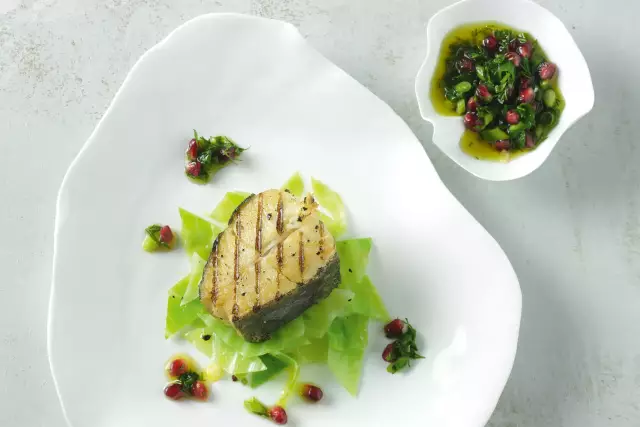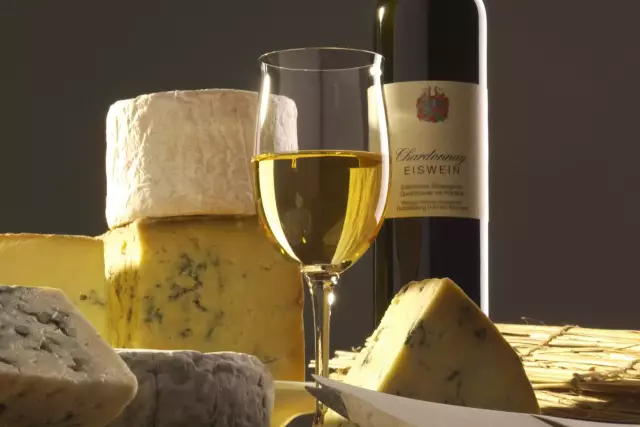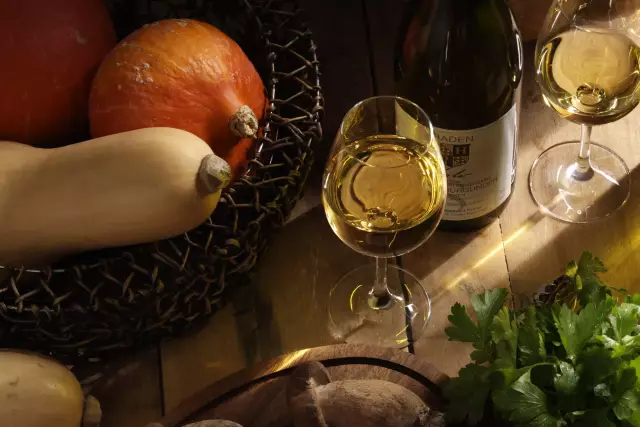Fondue & Wine

Long winter evenings and New Year’s Eve are excellent opportunities for a fondue or raclette in delightful company. And the enjoyment is enhanced if the culinary diversity is complemented by suitable wines. Ernst Büscher of Wines of Germany (DWI) recommends: “Ideally, you should already consider your guests’ wine preferences when you choose the style of the fondue.”
Facts
-
100 degrees
hot grease or broth
-
Infinite
variations to choose
A great variety of nuances is added by the many potential side dishes and condiments, which should also be considered when you chose a suitable wine. “The sauces are frequently more dominant in taste than the meat you are using,” Ernst Büscher explains. A fruity, slightly hot chutney, for instance, makes for a harmonious combination with a semi-dry Riesling. However, rich mayonnaise-based sauces correspond ideally with powerful Pinot Gris, and fragrant dips with an Asian touch like to enter into a playful liaison with fruity Pinot Blanc, Silvaner or a fresh Pinot Noir rosé.
The broad range of available fondues and raclettes offers a great diversity of exiting potential combinations with German wines. Wines of Germany (DWI) offers you a few guidelines for the suitable choice of wine:
Cheese fondue
is mostly prepared with melted Gruyère, white wine and spices. A powerful Pinot Gris or Pinot Blanc, for instance from Baden, is the right companion for this rich dish. Traditional side dishes for the cheese fondue are mixed pickles, small gherkins and sometimes Bündnerfleisch. The acidity of the pickles makes the fondue more easily digestible, but it has to be taken into account as well when choosing the right wine. The acidity is nicely offset by a Rheingau Riesling with a little residual sugar. This wine also adds a fresh touch when you’re enjoying the cheese all by itself.
Meat fondue
often offers a broad selection of beef, pork or poultry. The pieces of meat are cooked in hot oil and seasoned with a variety of dips. Within this broad range of aromas, a truly versatile wine such as a fruity-fresh Pinot Gris from the Pfalz is recommended. A Pinot Noir Weißherbst is another wine that can play alongside all kinds of meat fondue. Particular care needs to be taken if you’re serving hot dips. The spiciness increases the perception of alcohol. Thus hot dips should be accompanied by light wines such as Riesling or Pinot Blanc Kabinett. Suitable red wine companions for spicy dishes are Pinot Noir or Lemberger, for instance from Württemberg.
Chinese fondue
This variety uses a mild broth rather than hot oil. When cooked in the broth, the meat does not develop roast aromas and retains a milder taste. As a rule, the choice of dips reflects this mildness. A suitable wine should be able to play along with a broad range of aromas. A Silvaner or Portugieser Weißherbst from Rheinhessen is particularly suitable.
Fish fondue
a delicate variety of companionable enjoyment. In a fish fondue, you use firm-fleshed kinds of fish, but also prawns, shrimps or other seafood varieties. These are quickly cooked in a fish fond. In this case, wine recommendations focus on white wines, since their aromas are well suited to accompany the subtle diversity of aromas of the fish and dips. Classics such as Moselle Riesling are particularly good with zander, trout and redfish. Delicate monkfish and fresh prawns like to be accompanied by Pinot Blanc from the wine-growing regions Palatinate or Saale-Unstrut. In the company of richer dips – such as the popular aioli – a heartier Silvaner from Franconia works well.
Where does the term fondue come from?
Fondue derives from "fondre", French for "to melt", and is originally a dish with melted cheese.
Varietals

More recipe ideas
with ribbon noodles Coq au Riesling
with ribbon noodles
- 1 ganzes Huhn
- 0,4 Liter Riesling
- 0,2 Liter Sahne
- 1 kl. Glas Cognac
- 2 Stück Schalotten
- 1 Stück Knoblauchzehe
- 1 Stück Eigelb
- 1/2 Bund Petersilie
- 1 EL Mehl
- 50 Gramm Butter
- 1 EL Olivenöl
- nach Belieben Salz & Pfeffer
Carve the chicken. Heat approx. 50 g butter with 2 tbsp olive oil in a large frying pan and fry the chicken pieces until light brown (without the lid). Season lightly with salt.
Finely chop the shallots, peel and finely chop the garlic. Chop the parsley and add everything to the meat. Sauté briefly with the pan closed. Pour the cognac over the meat and light it (flambé). Deglaze with 1/3 litre of Riesling and leave to simmer for half an hour over a low heat. If necessary, add a little more wine and simmer for a further 10 minutes.
Remove the chicken pieces and keep warm for a short time. Mix 1 tbsp of flour with 1 egg yolk and the cream and whisk into the sauce. Flavour with salt and pepper. Return the chicken pieces to the pan. Serve immediately.
This goes well with tagliatelle.
Variant:Fry 150 g fresh mushrooms in 50 g butter and add.
- Riesling (trocken)
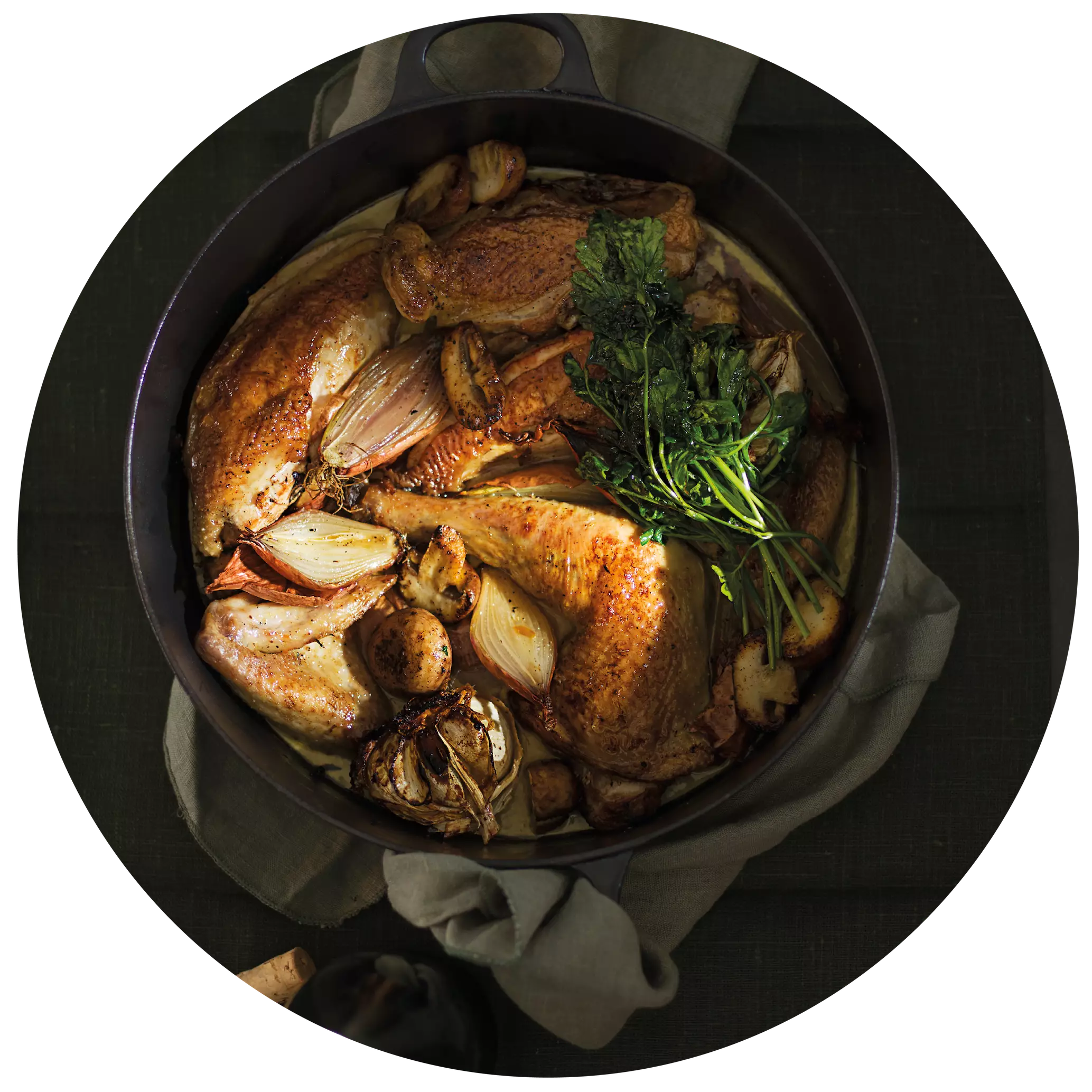
with bulgur Cabbage stew
with bulgur
- 200 Gramm Zwiebeln
- 1 ganze Knoblauchzehe
- 800 Gramm Spitzkohl
- 200 Gramm Möhren
- 400 Gramm festk. Kartoffeln
- 1 EL Kümmelsaat
- 1,5 Liter Gemüsefond
- 5 EL Olivenöl
- 2 EL Tomatenmark
- 2 EL edelsüßes Paprikapulver
- 3 TL Honig
- nach Belieben Salz & Pfeffer
- 120 Gramm grobe Bulgur
- 1 Bund Petersilie
- 4 Stiele Minze
- 1 ganze Zitrone
- 2 ganze Äpfel
- 3 EL Obstessig
Finely dice the onions and garlic. Clean, wash and quarter the cabbage, remove the stalk and roughly chop the cabbage quarters. Peel the carrots, halve lengthways and cut into approx. 2 cm wide pieces. Peel the potatoes and cut into approx. 2.5 cm pieces. Fry the carrots in a pan without fat and set aside.
Heat the vegetable stock in a small pan. Heat 3 tablespoons of oil in a large pan, sauté the cabbage in it for 10-15 minutes over a high heat until dark brown and remove from the pan.
Add the remaining oil to the pan. Fry the onions and garlic until translucent. Add the potatoes and muesli and sauté for 3-4 minutes, stirring constantly. Add the tomato purée and paprika powder and fry while stirring. Add the cabbage, honey and caraway and pour in the hot vegetable stock. Season with salt and pepper. Bring to the boil, cover and simmer for 45 minutes. Add the bulgur 20 minutes before the end of the cooking time.
Quarter the apples, remove the seeds, cut into approx. 1 cm cubes and add 10 minutes before the end of the cooking time. Pluck the herbs and chop medium-fine. Wash and dry the lemon, finely grate the zest and mix with the herbs. Flavour the stew with vinegar, salt and pepper and serve sprinkled with the herbs.
Tip: The pointed cabbage must be roasted really strongly and dark so that the aromas come out well.
- Spätburgunder / Pinot Noir (trocken)
- Trollinger (trocken)
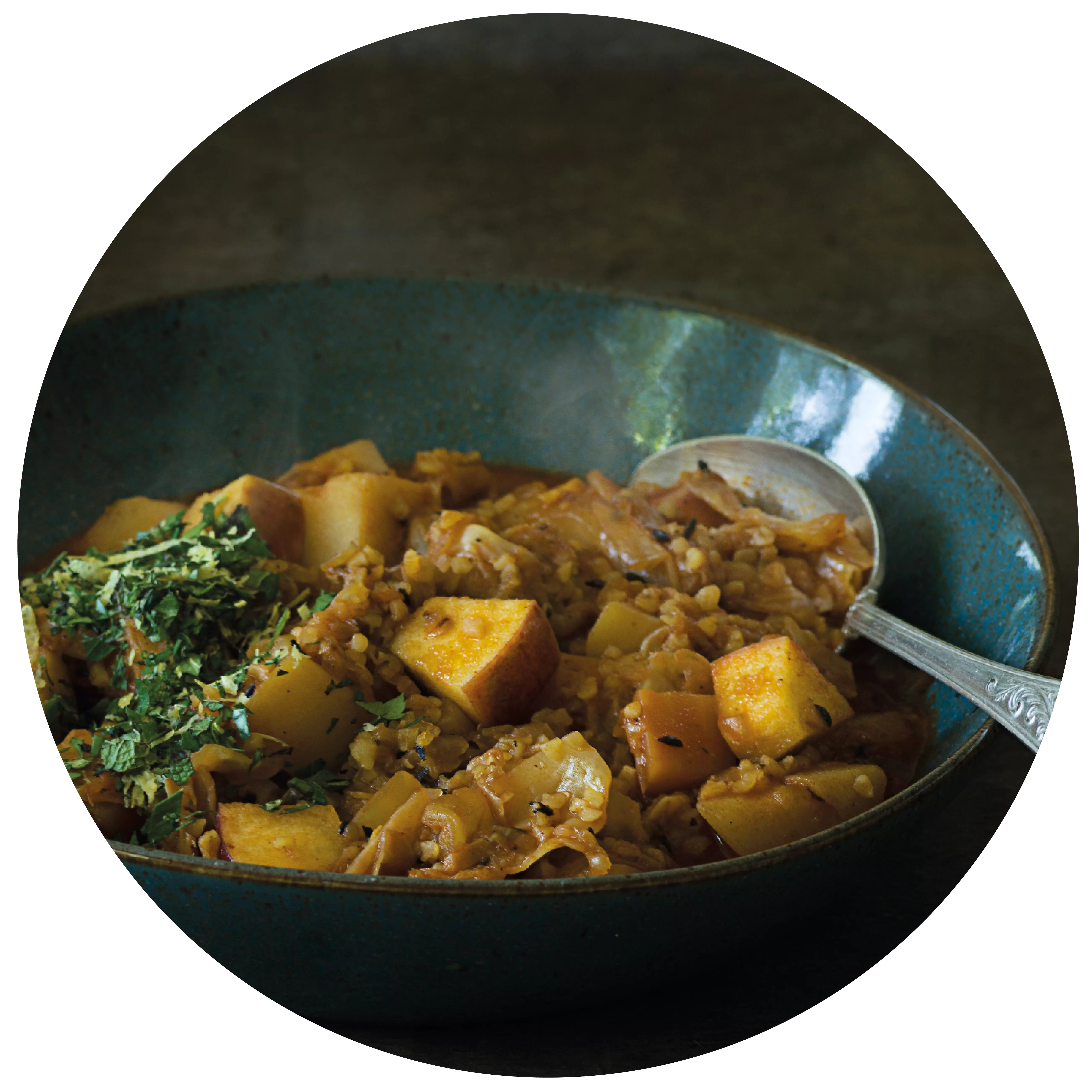
Wine recommendation: A white wine with a mellow flavour such as Pinot Gris or Chardonnay. Asparagus risotto al scampi
Risotto with green asparagus, scampi and parmesan.
- 400g Grüner Spargel
- 200g Küchenfertige Scampis
- 200g Risotto-Reis
- 250ml Trockener Weißwein
- 500ml Gemüsebrühe
- 50g Parmesan
- 1 Zwiebel
- 4EL Olivenöl
- 1Dose Safranfäden
- etwas Salz und Pfeffer
Peel the lower third of the asparagus and cut off the ends. Cut into 2 cm long pieces, cook in boiling salted water for approx. 5 minutes and drain. Cut the onion into thin slices and finely chop the garlic.
<p
<p>Heat 2 tbsp of oil, add the onion slices, garlic and rice
.
sauté until translucent. Deglaze with the white wine. Season with salt, pepper
and saffron to flavour. Add a little stock, bring to the boil and simmer, stirring constantly. Gradually add the remaining stock and simmer until the liquid has been absorbed by the rice. The rice should still have a bite on the inside.
Wash the scampi and grate the Parmesan. Heat 2 tbsp oil in a pan and fry the scampi for approx. 4 minutes. Season with salt and pepper. Stir the asparagus, scampi and parmesan into the risotto and serve.
Wine recommendation:
A white wine with a mellow flavour such as Pinot Gris or Chardonnay. Alternatively, a well-chilled, light Trollinger or Blanc de Noir from Pinot Noir.
<p- Pinot Gris (extra brut)
- Chardonnay (extra brut)
- Trollinger (brut)
- Spätburgunder / Pinot Noir (brut)

with chanterelle and onion leek, served with potato and grilled cheese ragout in grilled tomato Chop of Hunsrück veal
with chanterelle and onion leek, served with potato and grilled cheese ragout in grilled tomato
- 4 x 300 Gramm Kotelettes
- 250 Gramm Pfifferlinge
- 4 große Kartoffeln
- 2 große Grilltomaten
- 180 Gramm Flammkäse
- 50 Gramm Knollensellerie
- 200 ml Spätburgunder
- 200 ml Sahne
- 50 Gramm Butterschmalz
- 2 EL Butter
- 1 EL Rapsöl
- 6 Stück Lauchzwiebeln
- 1 kleine Knoblauchzehe
- je 1 Zweig Thymian & Rosmarin
- je 1 TL Majoran & Oregano
- nach Belieben Salz & Pfeffer
Peel the potatoes, celery and garlic clove, crush the garlic and cut the potatoes and celery into small cubes. Heat the rapeseed oil in a pan, add the potato and celery cubes, sauté briefly and top up with ⅔ of the cream. Season with salt, pepper and the crushed garlic and leave to simmer for approx. 6 minutes. Add the oregano, marjoram,
add a little thyme and the diced flambé cheese and remove from the oven immediately.
Season the veal chops with pepper, fry in the pan in hot clarified butter for approx. 3 to 4 minutes on both sides and then cook in the oven at 160 degrees for 8 to 9 minutes. Then leave the meat to rest briefly.
Cut the grilled tomatoes in half, remove the skin, place on a baking tray and fill with the potato and flambé ragout. Place the baking tray in the oven with the chops for approx. 6 - 7 minutes. Add 1 tbsp of butter and the sprig of rosemary to the roasting mixture, deglaze with the Pinot Noir, reduce a little and refine with the remaining cream. Season to taste with salt and pepper.
Clean the chanterelles and spring onions. Wash the spring onions well, cut into 5 cm pieces, blanch briefly in salted water and rinse in ice water. Heat 1 tbsp butter in a pan, add the chanterelles and sauté for 2 - 3 minutes. Add the spring onions and the rest of the thyme and season with salt and pepper.
<p- Riesling (trocken)

Events
-
Show
winetasting in our winery - blind tasting
Mainz-Hechtsheim


